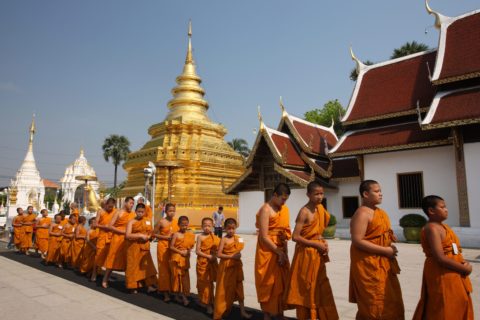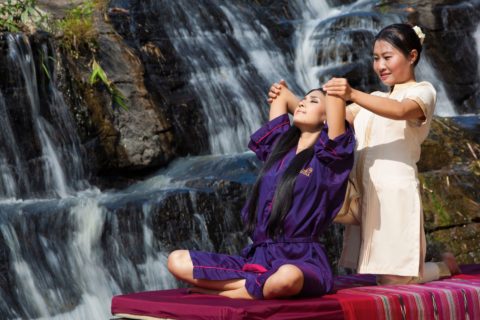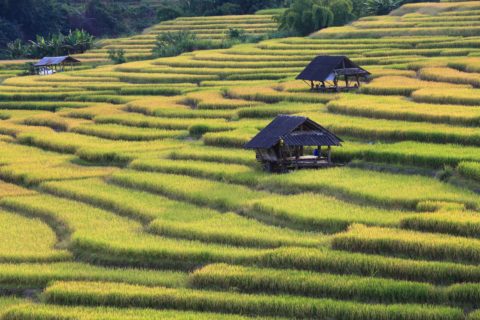The Hangover Cure, Part II: Ladies Love Thailand
Set in Thailand, The Hangover Part II depicted the debauched misadventures of four fellows, dubbed “the Wolf Pack.” I was not a fan. The movie portrayed a seedy side of Thailand complete with tattoo parlours and strip clubs. Too often Thailand gets tarred with such clichés.
Recently I enjoyed a romp around the Land of Smiles with three female friends. In many ways our trip was the antithesis of that of the Wolf Pack. Our group enjoyed at least one Thai massage or spa treatment per day, fine dining, cooking classes and some fascinating cultural visits.
Chiang Mai: Rose of the North
Capital of Northern Thailand, Chiang Mai was known as the Lanna Kingdom in the 13th century. Apart from being cooler and less hectic than Bangkok, Chiang Mai, is a captivating mix of ancient and modern.
We recovered from jet lag at the Akyra Hotel located in Chiang Mai’s trendiest neighbourhood known as Nimman Road. Room amenities included pillow menus, a Thai herbal sleep tonic and the makings for a different cocktail every evening. Those, plus an outdoor soaker tub, had me feeling quite chipper the following day.

With its many temples and saffron-swathed Buddhist monks, Chiang Mai is the ideal place to take part in an early-morning ritual. Their religion forbids the monks from asking for food, so the custom is to buy a basket from a vendor containing some rice and fruit, remove your shoes, kneel down and offer the basket to a passing monk. For this he’ll bless you. Whatever your beliefs, it’s an uplifting way to start your day.

After several visits to Thailand, I’ve discovered you can eat well just about anywhere—from a hole in the wall to a five-star hotel. In central Chiang Mai at Khao Soi we slurped on noodle curry soup sitting with locals on plastic chairs at long tables. A bowl of soup and dessert of mango sticky rice costs about $2.00.
Back at the Akyra, the chef led us to the local market to shop for ingredients for our cooking class. We tasted the king and queen of exotic fruits, the stinky durian and luscious mangosteen. Back at the hotel, we sliced and diced our way through some Thai favourites, such as tom yam (lemongrass/shrimp soup). Dinner was served by the rooftop pool, complete with a fuchsia sunset.
Give an unemployed elephant a bath
The elephant is revered in the Buddhist religion as a symbol of protection. Centuries ago, royals rode them in combats against the Burmese. More recently, elephants hauled lumber from Thai jungles. But when the teak exportation business dwindled, many pachyderms and their mahouts (trainers) became unemployed.
At the Patara Elephant Farm, the staff believes that everyone in the world is responsible for the care and well being of elephants.
Previously I had only viewed elephants from afar or behind bars, At Patara I found myself literally face-to-trunk with a family. I introduced myself to Memei and her daughter Naya. Nu, the mahout, handed me a basket of sugar cane sticks and bananas and told me to start feeding Memei. Elephants eat ten percent of their weight per day so feeding is an integral part of the bonding experience. My first reaction to being so close to these creatures was unnerving, especially when Naya playfully wound her trunk around my shoulders in order to grab a banana. Soon I relaxed. Elephants may be huge but they have a great deal of dignity and grace.
After the feeding, Nu gave me a leafy branch and instructed me to dust Memei’s coat. Then we ambled down and into a river for bath time. By the time I’d finished scrubbed every inch of Mamei she thanked me by filling her trunk with water and showering me.
I hope that old adage that “an elephant never forgets” is true. I certainly won’t forget this amazing experience.
After Mamei’s “spa treatment,” it was time for mine. At the Anantara Spa, I succumbed to the Lanna Ritual—a herbal footbath followed by a full body massage using Thai, Burmese and Chinese techniques.
The Anantara Chiang Mai Resort, formerly the British Consulate, was once a hotbed for espionage. In keeping with that reputation, the Service 1921 Restaurant and Bar is accessed by pushing a library wall panel. Voilà, as if you were in a 007 movie, a secret room appears. One of chef Chris’s top-secret recipes is braised tiger prawns set ablaze with chilli sauce served with chopped bamboo, shiitake and minced pork. Downstairs the award-winning mixologist creates smokin’ cocktails with the help of liquid nitrogen.
Goddess of Indigo
The next day I found myself up to my rubber-gloved wrists in a bubbling vat of indigo dye in the front yard of Patricia Cheesman. She’s a textile expert who, along with her daughter Lamorna, preserves and teaches ancient weaving and dying techniques at their Studio Naenna.
As part of her Weavers for Environment program, Cheesman offers tie-dying classes to visitors (reservations necessary), the opportunity to watch local women weaving and buy a one-of-a-kind souvenir. Women, mainly from the local Karen hill tribe, can earn fair trade wages and work from their homes. This, according to Cheesman, allows them time to continue with traditional ceremonies and harvests. Cheesman’s team offers satisfying life sustaining work to young women that promotes self-esteem—a positive alternative to migrating to the city to seek work, often in the sex trade.
I left Studio Naenna with a tie-dyed scarf and the satisfaction that I had contributed, in a small way, to Cheesman’s commendable endeavour.
Sensory Sensations on Koh Samui
Thailand’s third largest island, Koh Samui, is known for its beaches, seafood and spas. After a short flight from Chiang Mai, we boarded a catamaran for an exploration of Angthong National Marine Park, an archipelago of 42 islands with outcroppings of limestone “mountains.” We snorkelled around coral reefs and stopped for a seafood buffet lunch at floating restaurant in a fishing village.
Backpackers first discovered the beach shacks of Koi Samui in the 70s. Today the island is dotted with luxury hotels. At Six Senses Samui, the staff has created a symbiotic nature/nurture experience.

We began our visit with a Thai massage, said to have been created by Shivago Komarpaj, a physician who lived more than 2500 years ago who was the personal doctor to the Buddha.
The two-hour series of contortions and stretching movements are patterned on the Asanas of Hatha Yoga. Your masseuse might hike your legs over your head while she presses her elbow into your hamstrings. Don’t be alarmed when she turns you over and tries to twist you into a sitting pretzel. A Thai massage is more revitalizing than relaxing, but at the end you feel like you’ve had a total body workout. Beware: it can become addictive.
Our host explained that Six Senses is all about sustainability and giving back to the community as he gave us a tour of the goat farm, beehives and gardens. The staff can arrange tours to local schools or hospitals and the resort prioritizes buying from local farmers and producers.
Bangkok Bustle
After the gentle waves and breezes of Koi Samui, Bangkok is downright frenetic. But after weaving between tuk tuk drivers and bubble-gum pink taxis, we arrived at the St. Regis, Bangkok, an oasis of tranquility.
The first St. Regis hotel, opened in New York in 1904, was the brainchild of John Jacob Astor IV. Throughout the world, St. Regis hotels continue some unique Astor rituals. Every evening before sunset the head butler sabres a bottle of Champagne.
Astor also instigated butler service. Need your bag unpacked? Fancy a cup of tea? At St. Regis, the butler did it.
Afternoon tea is another Astor tradition. In Bangkok, guests can chose from a Thai version with spring rolls or the tradition Western with scones and clotted cream.
Flower Power
“If we could see the miracle of a single flower clearly, our whole life would change.” These words are from Siddhartha Gautama upon whose teachings Buddhism was founded. Floral offerings are an essential part of the Buddhist culture. Flower power is prevalent everywhere in Thailand, from the jasmine garlands hanging on your tuk tuk driver’s mirror to the lotus blossoms adorning spirit houses and temples.
At the Museum of Floral Culture, housed in a century-old teak mansion, we met the owner, Mr. Sakul Intakul. The Wizard of Blossoms has created masterpieces to celebrate the late King Bhumibol Adulyadej’s 60 years on the throne. He has also designed for Jean Paul Gaultier.
The Museum’s new Midnight Moon package promises the ultimate floral dining experience during which guests tour the museum, take part in a garland-making workshop and dine on a seven-course meal complete with edible petals.
Thai Highs
Suspended in the sky on the 63rd floor of The Dome at Lebua, the Sky Bar is a lofty spot to enjoy the best panoramic view of Bangkok’s skyline. This is the only place where our gals’ gang and the “Hangover” boys both enjoyed a night on the town. Created for the movie, the signature “hangovertini” is a feisty combination of green tea liquor, Martini Rosso, green apple juice and rosemary-infused honey.
Back down to earth, it was our last day in the Land of Smiles. I have always been gobsmacked by the variety of breakfast offerings in Thailand’s luxury hotels, but the St. Regis takes the cake, or should I say the bacon butty (that’s British for bacon on a bun) but here it comes with foie gras.
The St. Regis franchise is also famous for its variations on the Bloody Mary. Here, the “Hangover Cure” breakfast includes raw oysters and the Siam Bloody Mary laced with lemongrass. That’s about as close as my experience got to Hangover, Part II.









